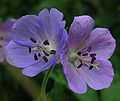Geraniaceae
| Geraniaceae | |
|---|---|
 | |
| Geranium rotundifolium | |
| Scientific classification | |
| Kingdom: | Plantae |
| (unranked): | Angiosperms |
| (unranked): | Eudicots |
| (unranked): | Rosids |
| Order: | Geraniales |
| Family: | Geraniaceae Juss.[1] |
| Genera | |
| |
Geraniaceae is a family of flowering plants placed in the order Geraniales. The family name is derived from the genus Geranium. The family includes both the genus Geranium (the cranesbills) and the garden plants called geraniums, which modern botany classifies as genus Pelargonium, along with other related genera.
There are around 800 species in the family, distributed in from 7 to 10 genera, according to the database of the Royal Botanic Gardens, Kew. Numerically, the most important genera are Geranium (430 species), Pelargonium (280 species) and Erodium (80 species).
Most species are found in temperate or warm temperate regions, though some are tropical. Pelargonium has its centre for diversity in the Cape region in South Africa, where there is a striking vegetative and floral variation.
Taxonomy
Hypseocharis, with between one and three species, which comes from the south-west Andean region of South America, is considered the sister to the rest of the family. Some authors separate Hyspeocharis as a monogeneric family Hypseocharitaceae,[3] while older sources placed it in the Oxalidaceae.
The genus Rhynchotheca has also been separated into the Vivianiaceae.
Description

Geraniaceae are herbs or subshrubs. The Sarcocaulon are succulent, but other members of the family generally are not.
Leaves are usually lobed or otherwise divided, sometimes peltate, opposite or alternate and usually have stipules.
The flowers are generally regular, or symmetrical. They are hermaphrodite, actinomorphic (radially symmetrical, like in Geranium) or slightly zygomorphic (with a bilateral symmetry, like in Pelargonium). The calyx and the corolla are both pentamerous (with five lobes), petals are free while sepals are connate or united at the base. The androecium consists in two whorls of five stamens each, some of which can be unfertile; the pistil consists of five (less commonly three) merged carpels. The linear stigmas are free, and the ovary is superior. Flowers are usually grouped in cymes (e. g. in Geranium), umbels (e. g. in Pelargonium) or, more rarely, spikes.
Geraniaceae are normally pollinated by insects, but self-pollination is not uncommon.
The fruit is a unique schizocarp made of five (or three) achenes, in the lower part the achenes are inside the calyx, while the upper part (the stylar beak) is the style of the flower, looking like a kind of long beak over the achenes. When the fruit is mature the style breaks into five (or three) hygroscopically active (ready to absorb water) bristles that curl, causing the achenes to be released.
Image gallery
-

Herbarium specimen of Geranium rotundifolium showing mature fruits
-

Immature fruits of Erodium botrys
-

Actinomorphic flowers of Geranium pratense
-

Zygomorphic flowers of a garden geranium (genus Pelargonium)
-

Cultivated Pelargonium umbels
-

Erodium cicutarium
-

Another flower diagram (Pelargonium zonale, three abortive stamens)
-
Sarcocaulon crassicaule
References
- ↑ Angiosperm Phylogeny Group (2009). "An update of the Angiosperm Phylogeny Group classification for the orders and families of flowering plants: APG III" (PDF). Botanical Journal of the Linnean Society 161 (2): 105–121. doi:10.1111/j.1095-8339.2009.00996.x. Retrieved 2013-07-06.
- ↑ Aldasoro, J.J.; Navarro, C.; P . Vargas; Saez, L.; Aedo, C. (2002). "California, a new genus of Geraniaceae endemic to the southwest of North America". Anales Jard. Bot. Madrid 59 (2): 209–216.
- ↑ Watson, L.; Dallwitz, M.J. (March 2011). "Angiosperm Families - Hypseocharitaceae Weddell". The families of flowering plants: descriptions, illustrations, identification, and information retrieval. Version: 4th. Retrieved April 14, 2012.
- Stevens, P. F. (2001 onwards). Angiosperm Phylogeny Website. Version 7, May 2006 [and more or less continuously updated since].
- (Italian) Sandro Pignatti, Flora d'Italia, Edagricole, Bologna 1982. ISBN 88-506-2449-2
- Geraniaceae of Mongolia in FloraGREIF
External links
| Wikimedia Commons has media related to Geraniaceae. |
